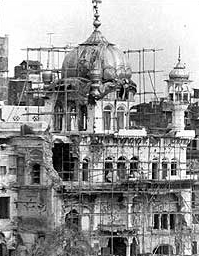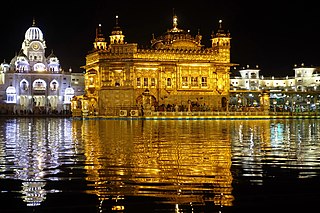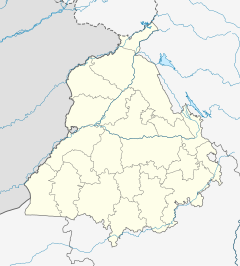
Operation Blue Star was the codename of a military operation carried out by Indian security forces between 1 and 10 June 1984 in order to remove Damdami Taksal, Jarnail Singh Bhindranwale and their followers from the buildings of the Golden Temple, the holiest site for Sikhs located in Amritsar, Punjab, India. The decision to launch the operation rested with the Prime Minister of India, then Indira Gandhi, who had already authorized military preparation for a confrontation at the temple complex 18 months prior according to the then-Vice Chief of the Army Staff, S. K. Sinha. In July 1982, Harchand Singh Longowal, the president of the Sikh political party Shiromani Akali Dal, had invited Bhindranwale to take up residence in the Golden Temple to evade arrest by government authorities.

Jarnail Singh Bhindranwale was the fourteenth jathedar, or leader, of the prominent orthodox Sikh religious institution Damdami Taksal. He was an advocate of the Anandpur Sahib Resolution, gaining national attention after his involvement in the 1978 Sikh-Nirankari clash.
A gurdwara is a place of assembly and worship for Sikhs. Sikhs also refer to gurdwaras as Gurdwara Sahib. People from all faiths are welcomed in gurdwaras. Each gurdwara has a Darbar Sahib where the current and everlasting guru of the sikhs, the scripture Guru Granth Sahib, is placed on a takhat in a prominent central position. The guru recite, sing, and explain the verses from the Guru Granth Sahib, in the presence of the congregation.
Beant Singh, was a bodyguard of the Prime Minister of India, Indira Gandhi, and was one of two who took part in her assassination in 1984.

The Insurgency in Punjab, from the mid-1980s to the mid-1990s, was an armed campaign by the Sikh militant nationalist Khalistan movement. In the 1980s, the movement had evolved into a secessionist movement after the perceived indifference of the Indian state in regards to mutual negotiations. The Green Revolution brought several social and economic changes which, along with factionalism of the politics, in the Punjab state increased tension between rural Sikhs in Punjab with the union Government of India. Pakistani strategists then began supporting the militant dimension of the Khalistan movement.

The Akal Takht is one of five takhts of the Sikhs. It is located in the Darbar Sahib complex in Amritsar, Punjab, India. The Akal Takht was built by Shri Guru Hargobind Ji as a place of justice and consideration of temporal issues; the highest seat of earthly authority of the Khalsa and the place of the Jathedar, the highest spokesman of the Sikhs. The current Jathedar of Akal Takht appointed by the Shiromani Gurdwara Parbandhak Committee is Singh Sahib Giani Harpreet Singh Ji, while the Sarbat Khalsa calls for the reinstitution of Giani Jagtar Singh Hawara.
Piara Singh Bhaniara also known as Baba Bhaniara, was a Dalit religious leader from Punjab, India. He established a breakaway Sikh sect in the 1980s, which was opposed by orthodox Sikhs as insulting to their faith. In 2001, his followers published their own holy text Bhavsagar Granth, and allegedly insulted the Sikh holy book Guru Granth Sahib. This sparked violence against Bhaniara's followers. The Punjab government banned Bhavsagar Granth, and arrested and jailed Bhaniara.
Harjinder Singh Jinda was a member of the Sikh separatist group Khalistan Commando Force and one of the two assassins of Arun Vaidya. He was responsible for three high-profile assassinations; Arjan Dass, Lalit Maken and Gen. Vaidya. He along with other members of Khalistan Commando Force participated in Indian history's biggest bank robbery of Rs. 57.0 million from Punjab National Bank, Miller Gunj branch, Ludhiana to finance the campaign for a separate Sikh state of Khalistan.

Gurmeet Ram Rahim Singh Insan, known also as MSG, is the head of the Indian social group Dera Sacha Sauda (DSS) since 1990. Prior to a 2017 rape conviction, he was a religious leader, actor, singer, writer, songwriter, director, and composer. He was also convicted of being involved in the murder of journalist Ram Chander Chhatrapati.
Sukhdev Singh Sukha was a Sikh, and member of the Khalistan Commando Force, a Sikh militant group and one of the assassins of Arun Vaidya, the Chief of Indian army at the time of Operation Blue Star to flush out heavily armed Anti government sikh militants hiding inside Golden Temple complex. He was responsible for three high-profile killings; Arjan Dass, Lalit Maken and Gen. Vaidya. He along with other extremist members of Khalistan Commando Force was involved in the bank robbery in Miller Gunj branch of the Punjab National Bank in which more than Rs 57.0 million were looted.

Ramgarhia Bunga or Burj is the three-storeyed red stone watchtowers complex located near southeastern edge of the Golden Temple, Amritsar. The two minaret-style Ramgarhia Bunga high towers are visible from the parikrama (circumambulation) walkway around the Harmandir Sahib Sarovar. It is a pre-Ranjit Singh structure built by Sikh warrior and Ramgarhia misl chief Jassa Singh Ramgarhia in late 18th-century, after the 1762 destruction and desecration of the Sikh holy temple and site by the Afghan Muslim forces led by Ahmed Shah Abdali. The Bunga watchtowers-related infrastructure was constructed to station sentinels to watch for any surprise attack, house soldiers to help fortify the area, and to protect the holy complex from desecration.

Gurdwara Darbar Sahib Kartarpur, also called Kartarpur Sahib, is a gurdwara in Kartarpur, located in Shakargarh, Narowal District, in the Punjab province of Pakistan. It is built on the historic site where the founder of Sikhism, Guru Nanak, settled and assembled the Sikh community after his missionary travels and lived for 18 years until his death in 1539. It is one of the holiest sites in Sikhism, alongside the Golden Temple in Amritsar and Gurdwara Janam Asthan in Nankana Sahib.

The Golden Temple is a gurdwara located in the city of Amritsar, Punjab, India. It is the preeminent spiritual site of Sikhism.
The Akali movement, also called the Gurdwara Reform Movement, was a campaign to bring reform in the gurdwaras in India during the early 1920s. The movement led to the introduction of the Sikh Gurdwara Bill in 1925, which placed all the historical Sikh shrines in India under the control of Shiromani Gurdwara Parbandhak Committee (SGPC).

A takht, or taḵẖata literally means a throne or seat of authority and is a spiritual and temporal centre of Sikhism. There are five Takhts, which are five gurudwaras that have a very special significance for the Sikh community. The first and the most important was established by Guru Hargobind in 1609, 'Akal Takht' and is just opposite the gate of Harmandir Sahib – The Golden Temple, Amritsar. While the Harmandir Sahib, or Golden Temple, represents Sikh spiritual guidance, the Akal Takht symbolizes the dispensing of justice and temporal activity. It is the highest seat of temporal authority of the Khalsa and the seat of the Sikh religion's earthly authority. There, the Guru held his court and decided matters of military strategy and political policy. Later on, the Sikh Nation took decisions here on matters of peace and war and settled disputes between the various Sikh groups. The Sarangi singers sung the ballads of the Sikh Gurus and warriors at the place and robes of honour (saropas) were awarded to persons who rendered distinguished services of the community of men in general. In December 2010, the Deccan Odyssey train, taken on charter from Government of Maharashtra, started with the aim to have a journey across four Sikh takhts, with a flight by devout and sightseers to the fifth takht. A special train named Panj Takht Special train for the pilgrimage of five Sikh takhts, was flagged off on 16 February 2014.
The Haryana Sikh Gurdwara Parbandhak Committee, HSGPC is an organization responsible for the upkeep of Sikh Gurdwara in Haryana, India. It was formally formed on 11 July 2014 by the bill was passed by Haryana Legislative Assembly. Before this the Gurdwaras of Haryana were officially under Shiromani Gurdwara Parbandhak Committee (SGPC). HSGPC would be headquartered at Kurukshetra. The formation of a separate Sikh body for Haryana has been widely opposed by SGPC and Shiromani Akali Dal, who sent a task force to various Gurdwara's in Haryana to maintain their control. As of 6 August 2014 the control of Gurdwaras in Haryana has not been formally handed over to HSGPC, and the Indian Supreme Court has ordered the status quo be maintained pending their ruling in the case.
The 1978 Sikh-Nirankari clash occurred between the Sant Nirankari Mission and traditional Sikhs on 13 April 1978 at Amritsar, Punjab, India. Sixteen people—thirteen traditional Sikhs and three Nirankari followers—were killed in the ensuing violence, occurring when some Akhand Kirtani Jatha and Damdami Taksal members led by Fauja Singh protested against and tried to stop a convention of Sant Nirankari Mission followers. This incident is considered to be a starting point in the events leading to Operation Blue Star and the 1980s insurgency in Punjab.
The 2015 Guru Granth Sahib desecration refers to a series of desecration incidents of the Sikh Guru Guru Granth Sahib and subsequent protests that took place in Punjab, India in October 2015, although it is known as the 2015 Guru Granth Sahib desecration it started from 2014 and continues till 2021. The first incident of desecration was reported from Bargari, Faridkot district, where 110 torn Angs of the holy Guru were found on 12 October. On the early morning hours of 14 October, two Sikhs were peacefully protesting and were shot dead by the police as the protesters were sitting in demonstration.

The Jathedar of the Akal Takht is the appointed head of the Akal Takht and the Sikhs of the world. Sikh clergy consists of five Jathedars, one each from five Takhts.
The 2021 Singhu border lynching refers to the lynching incident that occurred in the early hours of 15 October 2021 at Delhi's Singhu border, resulting in the death of Lakhbir Singh, a Dalit Sikh from Tarn Taran district of Punjab. The murder began with the victim's hand and a leg being chopped off, and later his body was hanged on a barricade near the farmers’ protest site. A Nihang Sikh group took responsibility for the lynching and killing, claiming that the man committed sacrilege of their holy scripture. A Nihang accepted his role in the murder, and surrendered on the same day. The second accused, who also belongs to the Nihang group, was arrested by the Amritsar police. After being taken into the police custody, the second accused claimed that he had surrendered before the police. Meanwhile, the Samyukta Kisan Morcha (SKM) distanced itself from the alleged lynching of the man, and agreed to cooperate with the police in the investigation. The Bhim Army extended financial support for the family of the victim and demanded an impartial probe from the CBI. In addition, 15 Dalit organizations have also called for strict action against the culprits in the killing of Lakhbir Singh at the Singhu border. Meanwhile, the victim's family has complained to the "National Commission for Scheduled Castes" about the lack of support from the Punjab state government.









